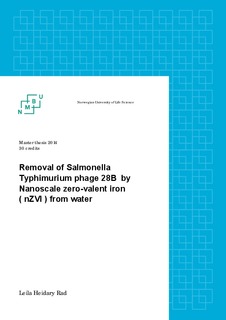| dc.contributor.author | Heidary Rad, Leila | |
| dc.date.accessioned | 2014-09-26T10:16:02Z | |
| dc.date.available | 2014-09-26T10:16:02Z | |
| dc.date.copyright | 2014 | |
| dc.date.issued | 2014-09-26 | |
| dc.identifier.uri | http://hdl.handle.net/11250/221752 | |
| dc.description.abstract | Providing drinking water free of viral pathogens is an issue of growing importance in many parts of the world. Historically the focus of water treatment has been on removing bacteria and other pathogens at water treatment sites. The 2 major methods apply for removing parasites and bacteria (filtration and chlorination) do not properly eliminate viruses. Viral outbreaks could be a potential threat for consumers of centralized and decentralized water treatment systems in the case of insufficient treatment. It has been shown in different studies that nanoiron would be efficient to remove a variety of chemical and pathogenic contaminants from water supplies, which opens up the possibility that it could be used for viral removal too. Previous studies have shown that nZVI can work for removal of some of viruses. The object of the present work was to assess the efficiency of commercial nZVI in removal of salmonella typhimurium 28B phage. This virus is chosen as a viral model as it is thermo tolerant and resistant to pH and therefore is a suitable representative for the worst case scenarios. The experiments were based on column studies where water contaminated with salmonella typhimurium 28B phage was introduced into 3 identical parallel columns with nZVI and three control columns containing only glass beads. Columns were packed in a sandwich form by 2 layers of glass beads which were surrounding nZVI. Slurries were prepared in proportions of 1 to 4 of nZVI powder to water. Applied retention time was 10 min and Q= 2 mL/min. The virus concentrations were estimated by the double layer agar method to count virus mean plaques for influent and effluents water samples. Results indicated a significant (up to 36.85%) reduction of virus concentration in outlets in comparison with outlet. Thus, as based on this pilot study, the use of nanoiron to remove viruses is a technique worthy of further investigation. | nb_NO |
| dc.language.iso | eng | nb_NO |
| dc.publisher | Norwegian University of Life Sciences, Ås | |
| dc.subject | VDP::Matematikk og Naturvitenskap: 400 | nb_NO |
| dc.subject | ST28B | nb_NO |
| dc.subject | Drinking water | nb_NO |
| dc.title | Removal of Salmonella Typhimurium phage 28B by Nanoscale zero-valent iron ( nZVI) from water | nb_NO |
| dc.type | Master thesis | nb_NO |
| dc.subject.nsi | VDP::Mathematics and natural science: 400::Chemistry: 440 | nb_NO |
| dc.source.pagenumber | 44 | nb_NO |
| dc.description.localcode | M-PV | nb_NO |
